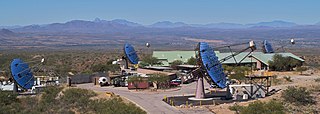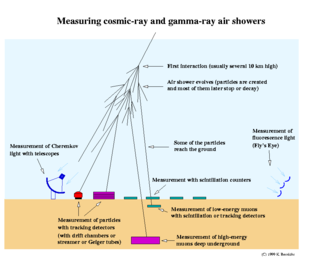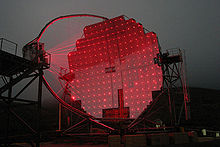
Cosmic rays or astroparticles are high-energy particles or clusters of particles that move through space at nearly the speed of light. They originate from the Sun, from outside of the Solar System in our own galaxy, and from distant galaxies. Upon impact with Earth's atmosphere, cosmic rays produce showers of secondary particles, some of which reach the surface, although the bulk are deflected off into space by the magnetosphere or the heliosphere.
The Greisen–Zatsepin–Kuzmin limit (GZK limit or GZK cutoff) is a theoretical upper limit on the energy of cosmic ray protons traveling from other galaxies through the intergalactic medium to our galaxy. The limit is 5×1019 eV (50 EeV), or about 8 joules (the energy of a proton travelling at ≈ 99.99999999999999999998% the speed of light). The limit is set by the slowing effect of interactions of the protons with the microwave background radiation over long distances (≈ 160 million light-years). The limit is at the same order of magnitude as the upper limit for energy at which cosmic rays have experimentally been detected, although indeed some detections appear to have exceeded the limit, as noted below. For example, one extreme-energy cosmic ray, the Oh-My-God Particle, which has been found to possess a record-breaking 3.12×1020 eV (50 joules) of energy (about the same as the kinetic energy of a 95 km/h baseball).

The Fermi Gamma-ray Space Telescope, formerly called the Gamma-ray Large Area Space Telescope (GLAST), is a space observatory being used to perform gamma-ray astronomy observations from low Earth orbit. Its main instrument is the Large Area Telescope (LAT), with which astronomers mostly intend to perform an all-sky survey studying astrophysical and cosmological phenomena such as active galactic nuclei, pulsars, other high-energy sources and dark matter. Another instrument aboard Fermi, the Gamma-ray Burst Monitor, is being used to study gamma-ray bursts and solar flares.

Neutrino astronomy is the branch of astronomy that gathers information about astronomical objects by observing and studying neutrinos emitted by them with the help of neutrino detectors in special Earth observatories. It is an emerging field in astroparticle physics providing insights into the high-energy and non-thermal processes in the universe.

The CERN Axion Solar Telescope (CAST) is an experiment in astroparticle physics to search for axions originating from the Sun. The experiment, sited at CERN in Switzerland, was commissioned in 1999 and came online in 2002 with the first data-taking run starting in May 2003. The successful detection of solar axions would constitute a major discovery in particle physics, and would also open up a brand new window on the astrophysics of the solar core.

HEGRA, which stands for High-Energy-Gamma-Ray Astronomy, was an atmospheric Cherenkov telescope for Gamma-ray astronomy. With its various types of detectors, HEGRA took data between 1987 and 2002, at which point it was dismantled in order to build its successor, MAGIC, at the same site.

Air showers are extensive cascades of subatomic particles and ionized nuclei, produced in the atmosphere when a primary cosmic ray enters the atmosphere. When a particle of the cosmic radiation, which could be a proton, a nucleus, an electron, a photon, or (rarely) a positron, interacts with the nucleus of a molecule in the atmosphere, it produces a vast number of secondary particles, which make up the shower. In the first interactions of the cascade especially hadrons are produced and decay rapidly in the air, producing other particles and electromagnetic radiation, which are part of the shower components. Depending on the energy of the cosmic ray, the detectable size of the shower can reach several kilometers in diameter.

High Energy Stereoscopic System (H.E.S.S.) is a system of imaging atmospheric Cherenkov telescopes (IACTs) for the investigation of cosmic gamma rays in the photon energy range of 0.03 to 100 TeV. The acronym was chosen in honour of Victor Hess, who was the first to observe cosmic rays.

IACT stands for imaging atmosphericCherenkov telescope or technique. It is a device or method to detect very-high-energy gamma ray photons in the photon energy range of 50 GeV to 50 TeV.

A neutrino detector is a physics apparatus which is designed to study neutrinos. Because neutrinos only weakly interact with other particles of matter, neutrino detectors must be very large to detect a significant number of neutrinos. Neutrino detectors are often built underground, to isolate the detector from cosmic rays and other background radiation. The field of neutrino astronomy is still very much in its infancy – the only confirmed extraterrestrial sources as of 2018 are the Sun and the supernova 1987A in the nearby Large Magellanic Cloud. Another likely source is the blazar TXS 0506+056 about 3.7 billion light years away. Neutrino observatories will "give astronomers fresh eyes with which to study the universe".

VERITAS is a major ground-based gamma-ray observatory with an array of four 12 meter optical reflectors for gamma-ray astronomy in the GeV – TeV photon energy range. VERITAS uses the Imaging Atmospheric Cherenkov Telescope technique to observe gamma rays that cause particle showers in Earth's atmosphere that are known as extensive air showers. The VERITAS array is located at the Fred Lawrence Whipple Observatory, in southern Arizona, United States. The VERITAS reflector design is similar to the earlier Whipple 10-meter gamma-ray telescope, located at the same site, but is larger in size and has a longer focal length for better control of optical aberrations. VERITAS consists of an array of imaging telescopes deployed to view atmospheric Cherenkov showers from multiple locations to give the highest sensitivity in the 100 GeV – 10 TeV band. This very high energy observatory, completed in 2007, effectively complements the Large Area Telescope (LAT) of the Fermi Gamma-ray Space Telescope due to its larger collection area as well as coverage in a higher energy band.

The Cherenkov Telescope Array, or CTA, is a multinational, worldwide project to build a new generation of ground-based gamma-ray instruments in the energy range extending from some tens of GeV to about 300 TeV. It is proposed as an open observatory and will consist of two arrays of imaging atmospheric Cherenkov telescopes (IACT), a first array at the Northern Hemisphere with emphasis on the study of extragalactic objects at the lowest possible energies, and a second array at the Southern Hemisphere, which is to cover the full energy range and concentrate on galactic sources. The physics program of CTA goes beyond high-energy astrophysics into cosmology and fundamental physics.

A cosmic-ray observatory is a scientific installation built to detect high-energy-particles coming from space called cosmic rays. This typically includes photons, electrons, protons, and some heavier nuclei, as well as antimatter particles. About 90% of cosmic rays are protons, 9% are alpha particles, and the remaining ~1% are other particles.

Gamma-ray astronomy is a subfield of astronomy where scientists observe and study celestial objects and phenomena in outer space which emit cosmic electromagnetic radiation in the form of gamma rays, i.e. photons with the highest energies at the very shortest wavelengths. Radiation below 100 keV is classified as X-rays and is the subject of X-ray astronomy.

Very-high-energy gamma ray (VHEGR) denotes gamma radiation with photon energies of 100 GeV (gigaelectronvolt) to 100 TeV (teraelectronvolt), i.e., 1011 to 1014 electronvolts. This is approximately equal to wavelengths between 10−17 and 10−20 meters, or frequencies of 2 × 1025 to 2 × 1028 Hz. Such energy levels have been detected from emissions from astronomical sources such as some binary star systems containing a compact object. For example, radiation emitted from Cygnus X-3 has been measured at ranges from GeV to exaelectronvolt-levels. Other astronomical sources include BL Lacertae, 3C 66A Markarian 421 and Markarian 501. Various other sources exist that are not associated with known bodies. For example, the H.E.S.S. catalog contained 64 sources in November 2011.

The High Altitude Water Cherenkov Experiment or High Altitude Water Cherenkov Observatory is a gamma-ray and cosmic ray observatory located on the flanks of the Sierra Negra volcano in the Mexican state of Puebla at an altitude of 4100 meters, at 18°59′41″N97°18′30.6″W. HAWC is the successor to the Milagro gamma-ray observatory in New Mexico, which was also a gamma-ray observatory based around the principle of detecting gamma-rays indirectly using the water Cherenkov method.
TXS 0506+056 is a very high energy blazar – a quasar with a relativistic jet pointing directly towards Earth – of BL Lac-type. With a redshift of 0.3365 ± 0.0010, it has a luminosity distance of about 1.75 gigaparsecs. Its approximate location on the sky is off the left shoulder of the constellation Orion. Discovered as a radio source in 1983, the blazar has since been observed across the entire electromagnetic spectrum.
The Large High Altitude Air Shower Observatory (LHAASO) is a gamma-ray and cosmic-ray observatory in Daocheng, in the Garzê Tibetan Autonomous Prefecture in Sichuan, China. It is designed to observe air showers triggered by gamma rays and cosmic rays. The observatory is at an altitude of 4,410 metres (14,470 ft) above sea level. Observations started in April 2019.
Indirect detection of dark matter is a method of searching for dark matter that focuses on looking for the products of dark matter interactions rather than the dark matter itself. Contrastingly, direct detection of dark matter looks for interactions of dark matter directly with atoms. There are experiments aiming to produce dark matter particles using colliders. Indirect searches use various methods to detect the expected annihilation cross sections for weakly interacting massive particles (WIMPs). It is generally assumed that dark matter is stable, that dark matter interacts with Standard Model particles, that there is no production of dark matter post-freeze-out, and that the universe is currently matter-dominated, while the early universe was radiation-dominated. Searches for the products of dark matter interactions are profitable because there is an extensive amount of dark matter present in the universe, and presumably, a lot of dark matter interactions and products of those interactions ; and many currently operational telescopes can be used to search for these products. Indirect searches help to constrain the annihilation cross section the lifetime of dark matter , as well as the annihilation rate.
Mary Paula Chadwick is a British physicist who is professor and head of the Department of Physics at Durham University. Her research investigates gamma-ray astronomy and astroparticle physics. She is involved with the Cherenkov Telescope Array.


















